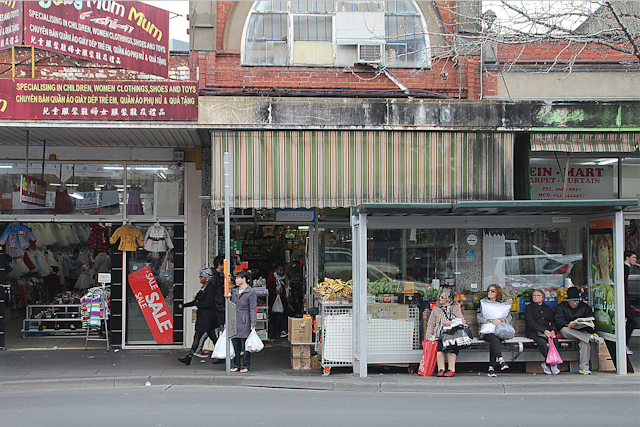Those who value “multiculturalism” and “access to the city” as key markers of a vibrant, progressive city will find these attributes in the Melbourne suburb of Footscray. Yet, at the same time, they will find them under threat through the forces of gentrification. These are the same forces that have, through time, transformed former “slums” such as Carlton, Fitzroy, Abbotsford and Richmond into “blue-ribbon” suburbs of Melbourne.
It is, inevitably, Footscray’s turn because of its proximity to the CBD. Many outside stakeholders have aspirations and conceptualised visions for the suburb.
These emerged at the turn of the millennium, when the Melbourne 2030 plan and its subsequent updates envisioned a new “central activity area” in Footscray.
A suburb in transition
In response to the metropolitan plans, substantial changes have been made to the council’s planning framework. New schemes allow for developments up to 25 storeys high along the banks of the Maribyrnong River and over the Footscray Market site.
With public investment to match, further catalysts of urban renewal were the substantial upgrade of Footscray railway station and other investments to polish the public realm.

Following the script of urban intensification, apartments have mushroomed in and around the suburb – with developers and investors colluding to rewrite and perpetuate new narratives.
In a tacit attempt to dilute Footcray’s shadier reputation, the suburb has been reimagined as the next “St Kilda” or “Fitzroy”. This has helped to raise unit prices and attract different types of residents and businesses.
These market-led models of urban development and renewal discount Footscray’s existing socio-physical and cultural landscape. The result is exclusionary, culturally homogeneous places and spaces. These reflect the fundamental top-down global and cultural drivers of the city in the race to climb (or, in Melbourne’s case, retain) liveability rankings.
On the contrary, multiculturalism is essentially a bottom-up phenomenon: ethnic enclaves form organically in the process of migrants settling down and “accessing the city” economically, socially and culturally. This is something that cannot be planned nor designed, but can be assisted.

In fact, Footscray has been an exemplar of this practice. The suburb’s absorption of immigrants has given rise to distinct Vietnamese, South Asian and Horn of African commercial precincts.
Improvement or displacement?
Formal agents of change (politicians, administrators, planners, designers) seem to view this urban condition as a temporary, transitional state to be eventually “improved”. They are often narrowly focused on physical and economic benchmarks.
The changes are compounded by a contemporary housing affordability crisis. Footscray has been attracting a local migration of first-home buyers and “hipsters” searching for more affordable properties and rent.
One might argue that this is a recipe for a multiculturalism where differences co-exist – or at least are juxtaposed. That might be true, if only the local white gentrification culture does not displace the minority cultures and socio-economic groups, as is happening to newer outer centres such as Sunshine and Broadmeadows.
Footscray’s beating heart
Critically, many may not realise the tenuous vulnerability of the place.
Last December, Footscray lost one of its most substantial cultural institutions, when the Little Saigon Market burnt down due to an electrical fault. Befitting current development trends, there are now plans for the site to become a 12-storey “mixed use” apartment building.
Both Footscray Market and Little Saigon Market are the key urban centres that sustain the commercial, culinary and cultural life of the suburb. However, Footscray Market is wholly owned by an individual – and there has been a proposal to replace it with a ubiquitous “mixed use” tower-on-podium development. This would (and still could) hasten the demise of Footscray’s distinctive character.

This is in stark contrast to the hundreds of millions of dollars being invested in Melbourne’s Queen Victoria Market and other markets. Established during the European colonisation and migration period, these have accrued heritage status. This arguably implies that Footscray’s markets are “minority markets” for lesser sub-cultures.
Significantly, in Footscray, multiculturalism and access to the city are lived experiences. The spatial and social implications are reflected in the ways buildings are used and goods are sold on the street.

A walk along Leeds Street reveals the finest scale of commercial practice by individual vendors. They hand-carry or push their cultural-specific wares on shopping trolleys – tactics to camouflage their subversive practices in busy pedestrian areas.
A different story
What we advocate for here is that there are alternatives to the ubiquitous developer-driven urbanisation; these make it possible to carefully consider the local communities directly affected by developments.
The City of Melbourne’s complex negotiations between developers and key stakeholders at Queen Victoria Market offers a potential local model. There’s no reason this model could not be carefully applied and extended to Footscray’s markets.
Complementing the markets, Footscray’s small and fine-scaled businesses should be recognised as alternative models of urban vibrancy and participative, socioeconomic resilience.
These are highly interrelated practices, which help mitigate socio-economic inequity, while meaningfully contributing to and showcasing Melbourne’s multiculturalism.
This article was written in collaboration with Jimi Connor, designer and independent researcher. It is based on ongoing research projects with Tahj Rosmarin and Amanda Achmadi.

